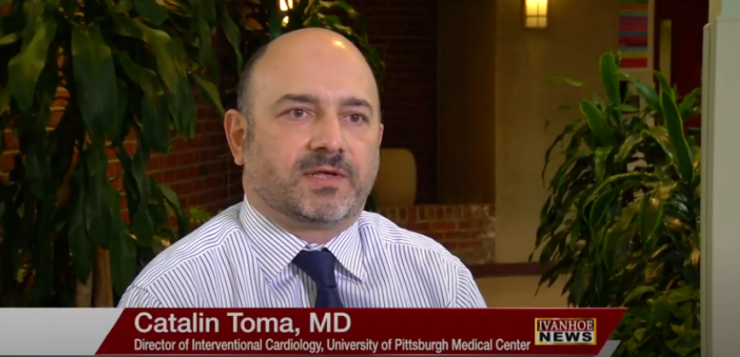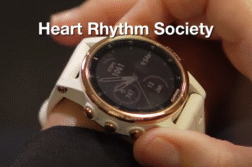Catalin Toma, MD, Director of Interventional Cardiology, University of Pittsburgh Medical Center talks about a new device for treating pulmonary embolism.
Dr. Toma, I want to start by asking you about FlowTriever. Could you describe what it is and what it’s designed to do?
TOMA: So, the FlowTriever is a dedicated device designed to extract clots from the pulmonary vasculature in patients with pulmonary embolism. This is the first device of its kind, specifically FDA approved for this goal. It consists of a large bore aspiration catheter. And this forms that you pass across the clot and retrieve them with the clot in it. It’s been approved for about two years now. And it’s part of our armamentarium for treatment of PE patients.
What’s the benefit to having a device like this for PE patients?
TOMA: So, two things. One is the fact that this device, unlike prior methods of treating PE does not require thrombolytics, medications that breaks the clot which comes with the risk. And the risk is that of bleeding, especially bleeding in the head or severe bleeding. So, it doesn’t use any thrombolytics. So, it’s particularly useful in patients who had a bleeding history or stroke or recent trauma, which are fairly common in the patients with PE. And the second thing is that it acts very quickly. It gives you a very quick effect. By taking the clot out, you see an immediate benefit on the table in terms of hemodynamic improvement, symptoms improvement, heart rate improvement in the patients.
Could you describe how this works? Is this considered a minimally invasive way of removing a clot?
TOMA: Yeah, it’s a minimally invasive procedure. We access the vein in the groin and through that we thread a catheter all the way up in the primary arteries, place the device next to the clot and basically aspirate the clot out. We do several passes on each side of the lung. And once we get the clot out and we measure hemodynamics and repeat the pictures, the procedure is over. It takes about an hour beginning to end.
And you’d mentioned the other option for patients is medication. Is there a window of time when FlowTriever works best?
TOMA: We think it works best in the very acute setting, but it’s approved for up to two weeks after the event occurred. The sooner the better, though, because the clot gets a little compacted. And it’s harder to extract after a while.
Could you tell me a little bit about the recent study?
TOMA: So, we have recently presented the results, the interim results of the Flash Registry, which is a national multicenter registry. We are part of it. We’re the leading center. We looked at about 200 patients with PE. This is the real-world experience with this device. The results are very encouraging. This was a registry primarily geared towards assessing the safety of the device, which turns out to be really good. There were no mortalities and almost no adverse events related to the device itself. The second objective was to look at how effective this device is in terms of improving the blood pressure and the hemodynamic parameters in patients with PE and succeeded at that as well with reduction in PE pressures and cardiac index. And this is a heart function.
Could you give me some specifics about the improvements that you saw in patients?
TOMA: Patients with pulmonary embolism develop pulmonary hypertension, the pressure inside the lung vasculature, it goes up. That puts a lot of strain on the heart. So, the heart fails. The right side of the heart fails. And that’s what leads to the morbidity and mortality associated with this disease. By taking the clot out, we decrease the pulmonary arterial pressure from a min of 36 to 25. The cardiac index, which is a measure of heart function, improved from 1.7 to 1.9 in patients with decreasing disease. And the tachycardia, which is the fast heart rate that these patients have, decreased significantly from about 110 to 90 beats per minute.
So, what are the implications then from this study? This device, of course, was already FDA approved.
TOMA: So the most important thing is the device is safe, and it appears to be effective in terms of immediate improvement. We, of course, don’t have a comparison to anticoagulation alone or to clot-busting medicine. So that would be – the long-term goal would be to assess, to do a comparative study between the FlowTriever and more traditional ways of treating these patients, in particular anticoagulation alone.
How many centers?
TOMA: I think it’s about 15 centers.
When you hear that something, a device is FDA approved, we already assume that it’s safe. So why that second look in this study?
TOMA: Because the approval was predicated on an initial study that looked at lower risk patients. And it was safe in low risk patients. This next phase was let’s see if this device works in real world patients, so including patients who are sicker and make sure it’s safe in that patient population as well. So, it’s just additive to the original study. The approval process in this field does not require a large number of patients for device approval, and that’s why it’s a little hard to determine whether things are safe in the larger population at large so.
Could that extend to patients for whom this would be indicated? Was it approved for just low risk?
TOMA: No, it wasn’t approved for low risk. It was approved for the treatment of PE essentially without a specific designation of low risk for high risk. And in general, we don’t do this intervention in patients who are low risk. We tend to do it because, you know, it’s more elaborate. It’s more costly, so we reserve it for patients that we really feel like they need something more in addition to Heparin alone or anti-coagulation alone.
You had mentioned maybe the next step would be to compare the FlowTriever to anticoagulants. Is that something that you see happening? Is it something that’s already in the works?
TOMA: That’s the plan, the long-term plan. We’re not there yet. So, this registry needs to complete its enrollment. There’s going to be a parallel arm that’s going to enroll soon with patients treated with Heparin alone. This is not a comparative study, though, at this point. And ultimately, the goal is to compare the two. However, the financial implication of that is significant. I mean, it’s a big endeavor, basically. And we want to make sure that we look at the right patients, the right patients that would benefit from this and not include a lot of low risk patients and then end up with a negative study and not learn anything from it.
So, is there anything I did not ask you that you want people to know?
TOMA: No, I think the important thing is to emphasize the fact that patients that experience symptoms suggestive of B, such as acute onset shortness of breath, chest pain, palpitations and fainting or dizziness or passing out should seek immediate attention. This is not a trivial thing. The sooner we get to this patient, the better the outcomes are.
And any recent statistics on how many people in the United States have this in a year?
TOMA: I can tell you is the third cause of cardiovascular mortality behind MI stroke, PE is the following. The other thing is – and I know you were mentioning that pretty much everybody cares about COVID nowadays – is in the setting of COVID, there is an increased propensity to clot. So there is this concept that patients with COVID may have a higher propensity to develop clots in their legs and MPEs. And there’s been reported to patients with COVID having PEs and there’s been reports of patients with COVID having PEs that were treated with this device.
Interview conducted by Ivanhoe Broadcast News.
END OF INTERVIEW
This information is intended for additional research purposes only. It is not to be used as a prescription or advice from Ivanhoe Broadcast News, Inc. or any medical professional interviewed. Ivanhoe Broadcast News, Inc. assumes no responsibility for the depth or accuracy of physician statements. Procedures or medicines apply to different people and medical factors; always consult your physician on medical matters.
If you would like more information, please contact:
Sheila Davis
412-313-6070
Sign up for a free weekly e-mail on Medical Breakthroughs called First to Know by clicking here




